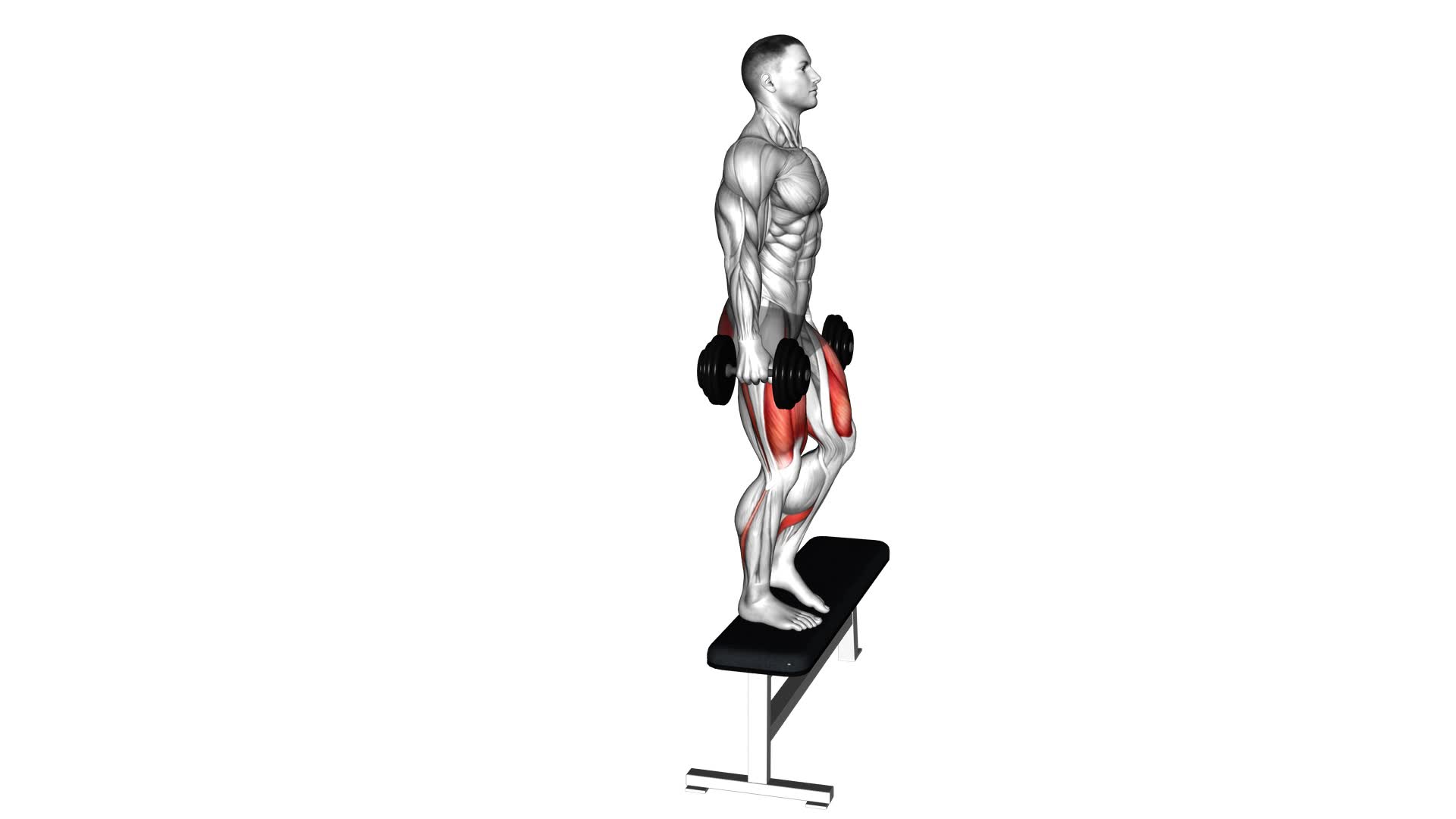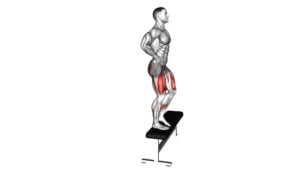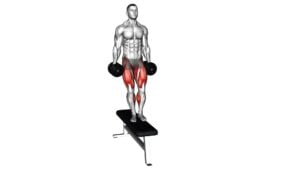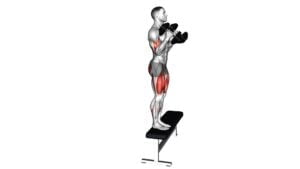Dumbbell Step-up (VERSION 2) (male) – Video Exercise Guide & Tips

Are you looking to step up your workout routine?
Watch This Exercise Video
Check out this video exercise guide to learn all about the dumbbell step-up (version 2) for males.
This exercise offers a range of benefits, from strengthening your lower body to improving balance and stability.
With proper form and technique, you can maximize your results and take your fitness to the next level.
So grab your dumbbells and get ready to step up your game!
Key Takeaways
- Dumbbell step-up exercise increases lower body strength and improves balance and stability.
- It targets multiple muscle groups such as glutes, quadriceps, hamstrings, and calves, promoting muscle growth and development.
- The exercise provides cardiovascular benefits and improves endurance.
- To maximize results, focus on proper form, choose a challenging weight, and gradually increase intensity and step height.
Benefits of Dumbbell Step-up Exercise
You can experience increased lower body strength and improved balance by incorporating the Dumbbell Step-up exercise into your fitness routine. This exercise targets multiple muscle groups, including the glutes, quadriceps, hamstrings, and calves, making it an effective way to activate and strengthen your lower body muscles. By stepping up onto a platform or bench while holding dumbbells in your hands, you're challenging your muscles to work against resistance, which promotes muscle growth and development.
In addition to building strength, the Dumbbell Step-up exercise also provides cardiovascular benefits. Performing this exercise in a continuous, rhythmic manner can elevate your heart rate and improve your cardiovascular endurance. This means that not only will you be building strength in your lower body, but you'll also be improving your overall fitness level and increasing your stamina.
To maximize the benefits of the Dumbbell Step-up exercise, it's important to maintain proper form and technique. By keeping your chest up, shoulders back, and core engaged throughout the movement, you can ensure that you're targeting the intended muscles and reducing the risk of injury. Additionally, be sure to choose an appropriate weight for the dumbbells to challenge yourself without compromising your form.
Proper Form and Technique
To maintain proper form and technique during the Dumbbell Step-up exercise, focus on keeping your chest lifted, shoulders back, and core engaged throughout the movement. This will help you maximize the benefits of the exercise and reduce the risk of common mistakes and common injuries.
One common mistake to watch out for is rounding your back. As you step onto the platform, make sure to keep your spine in a neutral position and avoid hunching forward. This will help prevent strain on your lower back and maintain proper alignment.
Another mistake to avoid is using too much momentum. It's important to control the movement and use your leg muscles to lift your body up onto the platform. Avoid pushing off with your back foot or swinging your body upward. This will ensure that you're effectively targeting the muscles in your legs and glutes.
In terms of common injuries, the most common one associated with the Dumbbell Step-up exercise is knee pain. To prevent this, make sure to step onto the platform with your whole foot and avoid excessive forward movement of your knee. Keep your knee aligned with your toes and engage your leg muscles to lift yourself up.
Choosing the Right Weight
Maintain the proper form and technique during the Dumbbell Step-up exercise to ensure you choose the right weight for an effective workout. Selecting appropriate dumbbells is crucial to optimize your results and avoid common mistakes.
Here are some tips to help you choose the right weight:
- Start with a lighter weight: Begin with a weight that challenges you but still allows you to maintain proper form throughout the exercise.
- Gradually increase the weight: As you become comfortable with the movement and your strength improves, gradually add more weight to continue challenging your muscles.
- Focus on your goals: Consider your fitness goals when selecting the weight. If you're aiming for muscle growth, choose a weight that allows you to perform 8-12 repetitions with proper form.
- Listen to your body: Pay attention to how your body feels during and after each set. If the weight feels too heavy and compromises your form, decrease the weight.
- Seek guidance if needed: If you're unsure about selecting the appropriate weight, consult a fitness professional who can provide guidance based on your individual needs and abilities.
By choosing the right weight, you can maximize the benefits of the Dumbbell Step-up exercise.
Now, let's explore some variations of the dumbbell step-up exercise.
Variations of Dumbbell Step-up Exercise
Now, let's explore how you can add variety to your Dumbbell Step-up exercise routine. By incorporating advanced modifications and balance challenges, you can take your workout to the next level.
To make the Dumbbell Step-up more challenging, you can increase the weight of the dumbbells you use. This will engage your muscles even more and help build strength.
Another advanced modification is to add a knee drive at the top of the movement. As you step up, bring your opposite knee up towards your chest, engaging your core and adding an extra challenge for your balance and stability.
Incorporating balance challenges into your Dumbbell Step-up routine can improve your overall balance and stability. One way to do this is by performing the exercise on an unstable surface, such as a Bosu ball or a foam pad. This will force your muscles to work harder to maintain balance and stability throughout the movement.
Another balance challenge is to perform the Dumbbell Step-up with a single leg. This won't only work your leg muscles but also improve your balance and coordination. Start with a lower step height and gradually increase it as you become more comfortable and confident.
Tips for Maximizing Results
Maximize your results with these effective tips:
- Focus on proper form: One of the most common mistakes people make when performing the dumbbell step-up exercise is using improper form. Ensure that your knee is directly above your ankle and your back is straight throughout the movement to maximize the effectiveness of the exercise and prevent injury.
- Choose the right weight: It's important to select a weight that challenges you without sacrificing proper form. Start with a weight that you can comfortably perform 8-12 repetitions with, and gradually increase the weight as you get stronger.
- Increase the intensity: To maximize results, you can increase the intensity of the exercise by adding additional weight or increasing the height of the step. This will help to further strengthen and tone your lower body muscles.
- Follow the recommended sets and reps: For optimal results, it's recommended to perform 2-3 sets of 8-12 repetitions per leg. This rep range helps to build strength and endurance in your legs.
- Incorporate rest days: Giving your muscles time to rest and recover is crucial for maximizing results. Aim to have at least one or two rest days between your dumbbell step-up sessions to allow your muscles to repair and grow stronger.
Frequently Asked Questions
How Many Calories Does the Dumbbell Step-Up Exercise Burn?
When you perform the dumbbell step-up exercise, you can burn a significant amount of calories. This exercise is highly effective for burning calories and improving overall fitness. By incorporating dumbbells into the exercise, you add resistance and engage more muscles, resulting in a higher calorie burn.
In addition to burning calories, the dumbbell step-up exercise also offers several fitness benefits. It helps in strengthening your lower body muscles and improving balance and coordination.
Can the Dumbbell Step-Up Exercise Help Improve Balance and Stability?
The dumbbell step-up exercise can definitely help improve your balance and stability. By incorporating this exercise into your routine, you'll be working on your coordination and enhancing your athletic performance.
It's a great way to challenge your muscles and improve your overall strength. Adding dumbbells to the step-up exercise increases the intensity and further engages your muscles.
Is It Safe to Perform the Dumbbell Step-Up Exercise if I Have Knee or Ankle Issues?
If you have knee or ankle issues, it's important to be cautious when performing the dumbbell step-up exercise. There are modification options available to make it safer for you.
For example, you can reduce the weight used or perform the exercise without the dumbbells altogether.
Additionally, there are alternative exercises that can help improve your lower body strength and stability without putting as much stress on your knees and ankles.
How Often Should I Incorporate the Dumbbell Step-Up Exercise Into My Fitness Routine?
To incorporate the dumbbell step-up exercise into your fitness routine, consider performing it two to three times a week. This will allow your muscles to recover and adapt to the exercise.
You can also try different variations of the dumbbell step-up to target different muscle groups and add variety to your routine.
Remember to maintain proper form for the exercise, keeping your back straight and stepping up with control.
Can the Dumbbell Step-Up Exercise Help With Building Muscle in the Lower Body?
The dumbbell step-up exercise is an effective way to build muscle in your lower body. By incorporating this exercise into your strength training routine, you can target muscles such as your quadriceps, hamstrings, and glutes.
This exercise requires you to step up onto a raised platform while holding dumbbells in your hands, adding resistance to the movement and increasing the challenge for your muscles.
Regularly performing dumbbell step-ups can help you develop strength and definition in your lower body.
Conclusion
In conclusion, the dumbbell step-up exercise is a highly beneficial workout that targets multiple muscle groups, including the legs, glutes, and core.
By maintaining proper form and technique, individuals can maximize the effectiveness of this exercise.
Choosing the appropriate weight and exploring variations of the step-up can also help to challenge and progress one's fitness level.
By following these tips, individuals can expect to see great results and improvements in their overall strength and endurance.

Author
Years ago, the spark of my life’s passion ignited in my mind the moment I stepped into the local gym for the first time. The inaugural bead of perspiration, the initial endeavor, the very first surge of endorphins, and a sense of pride that washed over me post-workout marked the beginning of my deep-seated interest in strength sports, fitness, and sports nutrition. This very curiosity blossomed rapidly into a profound fascination, propelling me to earn a Master’s degree in Physical Education from the Academy of Physical Education in Krakow, followed by a Sports Manager diploma from the Jagiellonian University. My journey of growth led me to gain more specialized qualifications, such as being a certified personal trainer with a focus on sports dietetics, a lifeguard, and an instructor for wellness and corrective gymnastics. Theoretical knowledge paired seamlessly with practical experience, reinforcing my belief that the transformation of individuals under my guidance was also a reflection of my personal growth. This belief holds true even today. Each day, I strive to push the boundaries and explore new realms. These realms gently elevate me to greater heights. The unique combination of passion for my field and the continuous quest for growth fuels my drive to break new ground.







